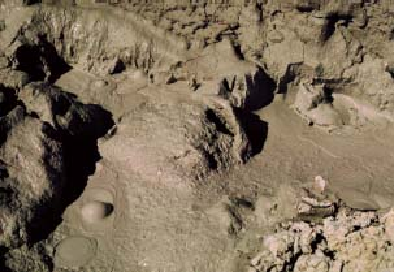Travel Reference
In-Depth Information
Mud pot near Imperial Geyser (Lower Geyser Basin).
Fumarole activity sometimes leads to development of another feature where little water is
present. The steam reacts chemically with the rocks and becomes very acidic, turning them in-
to clays. When enough clays have been made, they tend to form a bowl-shaped soupy mass, a
mud pot.
The steam coming up through the clay will now make mud bubbles, sometimes more
than 6 inches (15 cm) across. These are the delightful “blurping” bubbles that can be seen at
several park localities, including Fountain Paint Pot
[GEO.22]
and sometimes at Thumb Paint
Pots at West Thumb Geyser Basin
[GEO.23].
Most of the rocks underlying the hot water and steam features in the park are silica-rich
rhyolites. A major exception to this is the collection of terraced structures that have built up at
Mammoth Hot Springs
[GEO.24]
. Before reaching the surface, hot water rising there encoun-
ters
limestone
rather than rhyolite. Limestone, composed of
calcium carbonate,
is sedimentary
rock that was deposited in shallow seas and is mostly made up of the shells of marine organ-
isms.
Groundwater arriving under the Mammoth area dissolves some of the limestone and
brings it up to the surface, giving us another sort of
hot springs.
Here the water is under less
pressure. It can no longer hold all the carbon dioxide in solution, and some of the gas bubbles
escape, causing some of the dissolved calcium to deposit out, forming the terraces. This rock
is a white or gray form of limestone called
travertine.
The hot waters on Mammoth's terraces contain algae and bacteria that are orange, green,
yellow, or brown and coat the travertine with color. This ever-changing palette is dependent
upon the quantity and temperature of water at a particular spot. For more about the travertine
Two Unresolved Geological Questions

